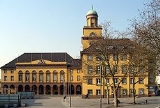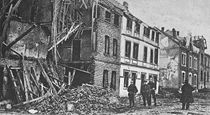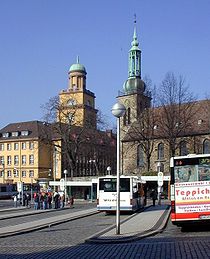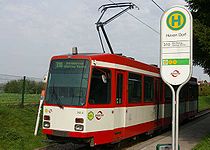
Witten
Encyclopedia
Witten is a university city in North Rhine-Westphalia
, Germany
. It is the home of the Witten/Herdecke University
, the first private university in Germany.
from East Prussia
and Silesia
, most of whom were Catholic. Hundreds settled in Witten, leading to a growth in the Catholic community. Today, between 30 and 40 per cent of the population is Catholic.
's Reformation
, and until the late 19th century, Witten was a predominantly Protestant town with just a few Catholic inhabitants. Between 30 and 40 percent of the population is Protestant today.
) of 9–10 November 1938. Today, only about a dozen Jews live in Witten. They belong to the Jewish community in Bochum
.
Since 1985 the place of the former synagogue is shown by a memorial for the victims of the holocaust.
lass="wikitable">
Year
Inhabitants
1. December 1890
26.310
2. December 1895
28.769
1. December 1900
33.517
1. December 1905
35.841
1. December 1910
37.450
1. December 1916
34.864
5. December 1917
35.033
8. October 1919
37.441
16. June 1925
45.519
16. June 1933
72.580
17. May 1939
73.365
31. December 1945
70.276
29. October 1946
69.384
lass="wikitable">
Year
Inhabitants
13. September 1950
76.312
25. September 1956
91.706
6. June 1961
96.462
31. December 1965
98.506
27. May 1970
97.379
31. December 1975
108.771
31. December 1980
105.876
31. December 1985
102.259
25. May 1987
102.902
31. December 1990
105.403
31. December 1995
104.754
31. December 2000
103.196
30. June 2005
101.019
 Witten was first mentioned in historic sources in 1214, however the borough
Witten was first mentioned in historic sources in 1214, however the borough
Herbede (which was incorporated into the city in 1975) dates back to 851. The city was a mining town from 1578. In 1946, it was included in North-Rhine Westphalia on its establishment. In 1975 Witten was included in the administrative district Ennepe-Ruhr-Kreis and it is now its biggest city. 1975 was also the year Witten was first counted to have more than 100,000 inhabitants, the threshold to be considered a large city ("Großstadt") in Germany.

, gained 24 councillors in the borough and form the largest party represented on the council, followed by the Christian Democratic Party, CDU
with 18 and the Greens
with 7. They are followed by the WBG (a conservative list) with 4, FDP 4, FLW (also a conservative list) 3, NPD
2, PDS/WAL (socialists) 1 and AUF Witten (a left wing list) also 1.
Since 2004 for the first time in its history the council is led by a female mayor: Sonja Leidemann, SPD
.
 Witten is connected to the Autobahn network by the A 43
Witten is connected to the Autobahn network by the A 43
and A 44
motorways. It has a central station
, connecting the city to the regional-train-network of Deutsche Bahn
.
Local service is carried out by the BOGESTRA
, a joint venture between the cities of Bochum and Gelsenkirchen, to which most of the bus lines in Witten belong. There is a tram line connecting to Bochum
. Public transport in the city is carried out according to the fare system of the VRR
transport association.
in May 1945, after the End of the Second World War.
with:
Beauvais
, France
, since 1975 London Borough of Barking and Dagenham
, United Kingdom
, since 1979 Mallnitz
, Carinthia
, Austria
, since 1979 Lev HaSharon
district, Israel
, since 1979 Wolfen
, Germany
, since 1990 Kursk
, Russia
, since 1990 Tczew
, Poland
, since 1990 San Carlos
, Nicaragua
(since 1990, friendship contract)
North Rhine-Westphalia
North Rhine-Westphalia is the most populous state of Germany, with four of the country's ten largest cities. The state was formed in 1946 as a merger of the northern Rhineland and Westphalia, both formerly part of Prussia. Its capital is Düsseldorf. The state is currently run by a coalition of the...
, Germany
Germany
Germany , officially the Federal Republic of Germany , is a federal parliamentary republic in Europe. The country consists of 16 states while the capital and largest city is Berlin. Germany covers an area of 357,021 km2 and has a largely temperate seasonal climate...
. It is the home of the Witten/Herdecke University
Witten/Herdecke University
Witten/Herdecke University is a private university in Witten, North Rhine-Westphalia, Germany. Unlike most other German universities, it is a private enterprise with about 1100 students and 400 employees...
, the first private university in Germany.
Bordering municipalities
- BochumBochumBochum is a city in North Rhine-Westphalia, western Germany. It is located in the Ruhr area and is surrounded by the cities of Essen, Gelsenkirchen, Herne, Castrop-Rauxel, Dortmund, Witten and Hattingen.-History:...
- DortmundDortmundDortmund is a city in Germany. It is located in the Bundesland of North Rhine-Westphalia, in the Ruhr area. Its population of 585,045 makes it the 7th largest city in Germany and the 34th largest in the European Union....
- HerdeckeHerdeckeHerdecke is a town in the district of Ennepe-Ruhr-Kreis, North Rhine-Westphalia in Germany. Its located south of Dortmund in the Ruhr Area and is known as Die Stadt zwischen den Ruhrseen ....
- Wetter (Ruhr)Wetter (Ruhr)Wetter is a town in western Germany and belongs to the area of Ruhr area and the federal state of North Rhine-Westphalia. Wetter belongs to the district of Ennepe-Ruhr-Kreis. The river Ruhr flows through the urban area and separates the district of Altwetter from the districts of Esborn,...
- Sprockhoevel
- HattingenHattingenHattingen is a German town located in northern part of the Ennepe-Ruhr-Kreis district, in North Rhine-Westphalia.-History:Hattingen is located on the south bank of the River Ruhr in the south of the Ruhr region. The town was first mentioned in 1396, when the Duke of Mark granted permission to build...
Division of the town
Witten is divided into 8 boroughs and every of these boroughs is divided into city-districts. Every district has it own district-number:- Witten-Mitte: 11 Innenstadt, 12 Oberdorf-Helenenberg, 13 Industriegebiet-West, 14 Krone, 15 Crengeldanz, 16 Hauptfriedhof, 17 Stadion, 18 Industriegebiet-Nord, 19 HohensteinWitten-HohensteinThe Hohenstein is the central forest of Witten, . As a forest its name is just "Hohenstein". But "Hohenstein" is also the name if a city-district of Wittens borough "Mitte". It has the district-number 19...
- Dueren: 21 Dueren-Nord, 22 Dueren-Sued
- StockumWitten-StockumWitten-Stockum is a borough of the City of Witten. It has about 6.300 inhabitants .-History:Stockum was first mentioned in 882 as villa stochem. Villa stochem was a little castle that was owned by a knight who called himself "op der Heyde"...
: 31 Stockum-Mitte, 32 Dorney, 33 Stockumer Bruch, 34 Wilhelmshoehe - AnnenWitten-AnnenSince 1929, Annen has been a part of the City of Witten . As one of the eight boroughs of Witten, it is now called Witten-Annen. Before the incorporation with Witten in 1929, Annen was part of the administrative district Landkreis Hoerde...
: 41 Tiefendorf, 42 WullenWitten-WullenWullen is a city-district of Witten-Annen, which is a part of the City of Witten, . Wullen is placed about 3 kilometres northeast of the City of Witten.-History:* 1019: First mentioned....
, 43 Annen-Mitte-Nord, 44 Annen-Mitte-Sued, 45 Kohlensiepen, 46 Wartenberg, 47 Gedern - Ruedinghausen: 51 Industriegebiet-Ost, 52 Ruedinghausen-Mitte, 53 Buchholz, 54 Schnee
- Bommern: 61 Steinhausen, 62 Bommerbank, 63 Bommerfeld, 64 Wettberg, 65 Buschey, 66 Bommeregge
- Heven: 71 PapenholzHeven-PapenholzPapenholz is a city-district of Witten-Heven, which is a part of the City of Witten, . Papenholz is placed about 3 kilometres northwest of the city. It has nearly no population. It is neither known when it was firstly nor who were the first settlers; it is a part of Witten-Heven since 1929. Before...
, 72 Hellweg, 73 Wannen, 74 Heven-Dorf, 75 Lake - HerbedeHerbedeSince 1975 the former city of Herbede is a part of the city of Witten . As one of the eight boroughs of Witten it now calls Witten-Herbede. Before the incorporation with Witten in 1975 Herbede has been a city in the administrative district Ennepe-Ruhr-Kreis...
: 81 Herbede-Ort, 82 Vormholz, 83 Bommerholz-Muttental, 84 Durchholz, 85 Buchholz-KaempenWitten-Buchholz-KaempenBuchholz-Kaempen [German: Buchholz-Kämpen] is a city-district of Witten-Herbede, which is a part of the City of Witten, . Buchholz-Kaempen is placed about 12 kilometres southeast of the city.-History:...
Roman Catholic
When Witten was first mentioned in historical documents, it was part of the Archdiocese of Cologne. Since 1821 it has been a part of the Diocese of Paderborn; however, the borough of Herbede belongs to the Diocese of Essen. In the 19th century the Ruhr area drew up to 500,000 PolesPoles
thumb|right|180px|The state flag of [[Poland]] as used by Polish government and diplomatic authoritiesThe Polish people, or Poles , are a nation indigenous to Poland. They are united by the Polish language, which belongs to the historical Lechitic subgroup of West Slavic languages of Central Europe...
from East Prussia
East Prussia
East Prussia is the main part of the region of Prussia along the southeastern Baltic Coast from the 13th century to the end of World War II in May 1945. From 1772–1829 and 1878–1945, the Province of East Prussia was part of the German state of Prussia. The capital city was Königsberg.East Prussia...
and Silesia
Silesia
Silesia is a historical region of Central Europe located mostly in Poland, with smaller parts also in the Czech Republic, and Germany.Silesia is rich in mineral and natural resources, and includes several important industrial areas. Silesia's largest city and historical capital is Wrocław...
, most of whom were Catholic. Hundreds settled in Witten, leading to a growth in the Catholic community. Today, between 30 and 40 per cent of the population is Catholic.
Protestant
In the 16th century Witten was influenced by Martin LutherMartin Luther
Martin Luther was a German priest, professor of theology and iconic figure of the Protestant Reformation. He strongly disputed the claim that freedom from God's punishment for sin could be purchased with money. He confronted indulgence salesman Johann Tetzel with his Ninety-Five Theses in 1517...
's Reformation
Protestant Reformation
The Protestant Reformation was a 16th-century split within Western Christianity initiated by Martin Luther, John Calvin and other early Protestants. The efforts of the self-described "reformers", who objected to the doctrines, rituals and ecclesiastical structure of the Roman Catholic Church, led...
, and until the late 19th century, Witten was a predominantly Protestant town with just a few Catholic inhabitants. Between 30 and 40 percent of the population is Protestant today.
Muslims
There are four mosques in Witten, Annen and Herbede today, founded by immigrants from Turkey who arrived in the 1970s and 1980s. Between five and eight percent of the population is Muslim.Jews
In 1815 the first Jewish community was mentioned in Witten. In 1938 the synagogue was destroyed during the so-called "Reichspogromnacht" (also known as KristallnachtKristallnacht
Kristallnacht, also referred to as the Night of Broken Glass, and also Reichskristallnacht, Pogromnacht, and Novemberpogrome, was a pogrom or series of attacks against Jews throughout Nazi Germany and parts of Austria on 9–10 November 1938.Jewish homes were ransacked, as were shops, towns and...
) of 9–10 November 1938. Today, only about a dozen Jews live in Witten. They belong to the Jewish community in Bochum
Bochum
Bochum is a city in North Rhine-Westphalia, western Germany. It is located in the Ruhr area and is surrounded by the cities of Essen, Gelsenkirchen, Herne, Castrop-Rauxel, Dortmund, Witten and Hattingen.-History:...
.
Since 1985 the place of the former synagogue is shown by a memorial for the victims of the holocaust.
Population 1739 - 2005
| class="wikitable"> | Year | Inhabitants |
|---|---|
| 1739 | 566 |
| 1787 | 690 |
| 1808 | 1.587 |
| 1830 | 2.210 |
| 1. December 1840 | 2.987 |
| 1. December 1855 | 5.112 |
| 3. December 1858 | 6.908 |
| 3. December 1864 | 10.500 |
| 3. December 1867 | 12.200 |
| 1. December 1871 | 15.161 |
| 1. December 1875 | 18.100 |
| 1. December 1880 | 21.600 |
| 1. December 1885 | 23.879 |
History

Borough
A borough is an administrative division in various countries. In principle, the term borough designates a self-governing township although, in practice, official use of the term varies widely....
Herbede (which was incorporated into the city in 1975) dates back to 851. The city was a mining town from 1578. In 1946, it was included in North-Rhine Westphalia on its establishment. In 1975 Witten was included in the administrative district Ennepe-Ruhr-Kreis and it is now its biggest city. 1975 was also the year Witten was first counted to have more than 100,000 inhabitants, the threshold to be considered a large city ("Großstadt") in Germany.
Roburit Explosion
In the late 19th century Witten was known for the Roburit dynamite. This dynamite was once used by coal mines around the world. In 1906 an explosion occurred, resulting in the deaths of 41 people.Politics

The Council of Witten
64 councillors form the council of Witten. In the local elections of 2004 the German Labour Party, SPDSocial Democratic Party of Germany
The Social Democratic Party of Germany is a social-democratic political party in Germany...
, gained 24 councillors in the borough and form the largest party represented on the council, followed by the Christian Democratic Party, CDU
Christian Democratic Union (Germany)
The Christian Democratic Union of Germany is a Christian democratic and conservative political party in Germany. It is regarded as on the centre-right of the German political spectrum...
with 18 and the Greens
Alliance '90/The Greens
Alliance '90/The Greens is a green political party in Germany, formed from the merger of the German Green Party and Alliance 90 in 1993. Its leaders are Claudia Roth and Cem Özdemir...
with 7. They are followed by the WBG (a conservative list) with 4, FDP 4, FLW (also a conservative list) 3, NPD
NPD
NPD may refer to:* National Democratic Party of Germany, a far-right political party in Germany; after its German language name, Nationaldemokratische Partei Deutschlands...
2, PDS/WAL (socialists) 1 and AUF Witten (a left wing list) also 1.
Since 2004 for the first time in its history the council is led by a female mayor: Sonja Leidemann, SPD
Social Democratic Party of Germany
The Social Democratic Party of Germany is a social-democratic political party in Germany...
.
German Bundestag
- 1998 - today: Dr. Ralf Brauksiepe, MdB (CDU)
- 1998 - today: Christel Humme, MdB (SPD)
- 2005 - today: Irmingard Schewe-Gerigk, (B´ 90/Die Grünen)
- 2005 - today: Konrad SchilyKonrad SchilyKonrad Schily is a member of the German parliament, the Bundestag. He is a neurologist and founded the Witten/Herdecke University, Germany's first private university, in 1982...
, (FDP)
Transport

Bundesautobahn 43
is an autobahn in western Germany, connecting Münster via Recklinghausen to Wuppertal. It is an important bypass for traffic coming from the A 1 wanting to go to the western Ruhr valley and wanting to avoid tailbacks at the Kamener Kreuz near Dortmund....
and A 44
Bundesautobahn 44
is a German Autobahn. It consists of three main-parts and a few smaller parts. It begins in Aachen at the German-Belgian border and ends near Kassel. Before the German unification it was an unimportant provincial-motorway but after this event it became an integral part of the German highway-system...
motorways. It has a central station
Witten Hauptbahnhof
is the Hauptbahnhof for the town of Witten in western Germany. It is situated southwest of the town.In 1849 the station was opened as Witten West by the Bergisch-Märkische Eisenbahn-Gesellschaft. At the end of the 19th century the whole station was reconstructed, the new station building was was...
, connecting the city to the regional-train-network of Deutsche Bahn
Deutsche Bahn
Deutsche Bahn AG is the German national railway company, a private joint stock company . Headquartered in Berlin, it came into existence in 1994 as the successor to the former state railways of Germany, the Deutsche Bundesbahn of West Germany and the Deutsche Reichsbahn of East Germany...
.
Local service is carried out by the BOGESTRA
BOGESTRA
The Bochum-Gelsenkirchener Straßenbahnen AG is a public transport operator in the Ruhr area, most notably in the cities of Bochum, Gelsenkirchen and Herne, and is integrated in the Rhine-Ruhr Stadtbahn network.-See also:* List of rapid transit systems...
, a joint venture between the cities of Bochum and Gelsenkirchen, to which most of the bus lines in Witten belong. There is a tram line connecting to Bochum
Bochum
Bochum is a city in North Rhine-Westphalia, western Germany. It is located in the Ruhr area and is surrounded by the cities of Essen, Gelsenkirchen, Herne, Castrop-Rauxel, Dortmund, Witten and Hattingen.-History:...
. Public transport in the city is carried out according to the fare system of the VRR
Verkehrsverbund Rhein-Ruhr
The Verkehrsverbund Rhein-Ruhr is the public transport association covering the area of the Rhine-Ruhr megalopolis in Germany...
transport association.
Coat of arms
The coat of arms of Witten with its two lions once belong to the Everhards von Witten-Steinhausen and was first mentioned in 1283. The family of Witten-Steinhausen belongs to the founders of the town of Witten. Their slogan was: "Sigillum Hermanni de Wittene". Because of its long history this Coat of arms was the only one in the Ruhr area, that was not forbidden by the AlliesAllies of World War II
The Allies of World War II were the countries that opposed the Axis powers during the Second World War . Former Axis states contributing to the Allied victory are not considered Allied states...
in May 1945, after the End of the Second World War.
Culture
- Hebezeug-Museum - A museum dedicated to cranes and hoist founded by J. D. NeuhausJ. D. NeuhausJ. D. Neuhaus is a German air hoist, winches and crane manufacturer head quartered in Witten. It is one of the oldest privately owned companies for more than 260 years in Germany.-History:...
and is located on the Route der Industriekultur. - Wittener Tage für neue KammermusikWittener Tage für neue KammermusikThe Wittener Tage für neue Kammermusik is a music festival for contemporary chamber music, jointly organised by the town Witten in the Ruhr Area and the broadcasting station Westdeutscher Rundfunk...
, festival for contemporary chamber music, held annually at the end of April
Twin towns - sister cities
Witten is twinnedTown twinning
Twin towns and sister cities are two of many terms used to describe the cooperative agreements between towns, cities, and even counties in geographically and politically distinct areas to promote cultural and commercial ties.- Terminology :...
with:
Beauvais
Beauvais
Beauvais is a city approximately by highway north of central Paris, in the northern French region of Picardie. It currently has a population of over 60,000 inhabitants.- History :...
, France
France
The French Republic , The French Republic , The French Republic , (commonly known as France , is a unitary semi-presidential republic in Western Europe with several overseas territories and islands located on other continents and in the Indian, Pacific, and Atlantic oceans. Metropolitan France...
, since 1975 London Borough of Barking and Dagenham
London Borough of Barking and Dagenham
In 1801, the civil parishes that form the modern borough had a total population of 1,937; and the area was characterised by farming, woodland and the fishing fleet at Barking. This last industry employed 1,370 men and boys by 1850, but by the end of the century had ceased to exist; replaced by...
, United Kingdom
United Kingdom
The United Kingdom of Great Britain and Northern IrelandIn the United Kingdom and Dependencies, other languages have been officially recognised as legitimate autochthonous languages under the European Charter for Regional or Minority Languages...
, since 1979 Mallnitz
Mallnitz
Mallnitz is a town in the district of Spittal an der Drau in Carinthia in Austria....
, Carinthia
Carinthia (state)
Carinthia is the southernmost Austrian state or Land. Situated within the Eastern Alps it is chiefly noted for its mountains and lakes.The main language is German. Its regional dialects belong to the Southern Austro-Bavarian group...
, Austria
Austria
Austria , officially the Republic of Austria , is a landlocked country of roughly 8.4 million people in Central Europe. It is bordered by the Czech Republic and Germany to the north, Slovakia and Hungary to the east, Slovenia and Italy to the south, and Switzerland and Liechtenstein to the...
, since 1979 Lev HaSharon
Lev HaSharon Regional Council
Lev HaSharon Regional Council is a regional council in the Center District of Israel. The council was established in 1984, unifying Hadar HaSharon and Northern Sharon regional councils, and covers 18 villages with a total area of 57,000 dunams and a population of 13,600.It borders Hefer Valley...
district, Israel
Israel
The State of Israel is a parliamentary republic located in the Middle East, along the eastern shore of the Mediterranean Sea...
, since 1979 Wolfen
Wolfen
Wolfen may refer to:In geography:* Wolfen, Germany, a town in Saxony-Anhalt, GermanyIn fiction:* The Wolfen, a 1978 horror novel by Whitley Strieber...
, Germany
Germany
Germany , officially the Federal Republic of Germany , is a federal parliamentary republic in Europe. The country consists of 16 states while the capital and largest city is Berlin. Germany covers an area of 357,021 km2 and has a largely temperate seasonal climate...
, since 1990 Kursk
Kursk
Kursk is a city and the administrative center of Kursk Oblast, Russia, located at the confluence of the Kur, Tuskar, and Seym Rivers. The area around Kursk was site of a turning point in the Russian-German struggle during World War II and the site of the largest tank battle in history...
, Russia
Russia
Russia or , officially known as both Russia and the Russian Federation , is a country in northern Eurasia. It is a federal semi-presidential republic, comprising 83 federal subjects...
, since 1990 Tczew
Tczew
Tczew is a town on the Vistula River in Eastern Pomerania, Kociewie, northern Poland with 60,279 inhabitants . It is an important railway junction with a classification yard dating to the Prussian Eastern Railway...
, Poland
Poland
Poland , officially the Republic of Poland , is a country in Central Europe bordered by Germany to the west; the Czech Republic and Slovakia to the south; Ukraine, Belarus and Lithuania to the east; and the Baltic Sea and Kaliningrad Oblast, a Russian exclave, to the north...
, since 1990 San Carlos
San Carlos, Río San Juan
San Carlos is the capital city of the municipality of San Carlos and of the Río San Juan Department of Nicaragua. The city proper has a population of roughly 12,174, while the city and surrounding communities contain 37,461 as of 2005. San Carlos is positioned on the confluence of Lake Nicaragua...
, Nicaragua
Nicaragua
Nicaragua is the largest country in the Central American American isthmus, bordered by Honduras to the north and Costa Rica to the south. The country is situated between 11 and 14 degrees north of the Equator in the Northern Hemisphere, which places it entirely within the tropics. The Pacific Ocean...
(since 1990, friendship contract)

